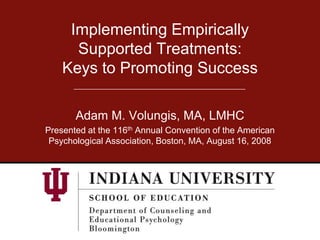
Implementing Empirically Supported Treatments
- 1. Implementing Empirically Supported Treatments: Keys to Promoting Success Adam M. Volungis, MA, LMHC Presented at the 116th Annual Convention of the American Psychological Association, Boston, MA, August 16, 2008
- 2. Implementation – Easier Said than Done • Need for empirically supported treatments (ESTs) has never been more important than the present o Increasing high bar for accountability o Strongly influenced by managed care • Implementing ESTs with demonstrated efficacy into a mental health setting does not guarantee effectiveness = compromised quality of care
- 3. Implementation – Easier Said than Done • Evidence-based interventions show the highest probability of success o With clients/problems for which it was designed o Demonstrate clinically relevant outcomes – In both scientific (clinical trials) and practical (community effectiveness) domains • Although there are numerous “proven” treatments for a variety of presenting problems, very few are being transferred into actual practice (Hayes, 2005) WHY?
- 4. Implementation – Easier Said than Done • Significant “gap” between research and application WHY? • Lag time between research results and translating into practice • Practitioner perceived rigidity of treatment (e.g., manuals) and/or practitioners’ lack of knowledge of research results (e.g., attitude) • Cost – implementation is often not cheap • Organizational Factors
- 5. Efficacy to Effectiveness • Efficacy – does the treatment work? o Treatment Efficacy (Best Practice [APA, 2000]) • Effectiveness – does the efficacious treatment work in real-world applications o Clinical Utility – “the applicability, feasibility, and usefulness of the intervention in the local or specific setting where it is to be offered” (Best Practice [APA, 2000, p.4])
- 6. Organizational Readiness for Change (ORC) • There are many organizational factors that cannot be ignored when implementing ESTs (Lehman, Greener, & Simpson, 2002) o Motivational Readiness o Institutional Resources o Staff Attributes (Practitioner & Administrative) o Organizational Climate
- 7. Implementation Case Example • A director of a community mental health agency wants to introduce an EST to the agency. There is increasing pressure to demonstrate client improvement and reduce cost. However, after discussing this idea with many of the staff and reviewing the agency’s resources the director has some significant concerns. There appears to be less than subtle resistance to providing services different from the status quo – e.g., “why change what already works?”, “I don’t want to lose my identity as a psychologist.” Furthermore, the current status of the agency does not appear to be well equipped with regard to technology and training resources. Finally, there has been concern about the overall organizational climate due to such factors as 2 consecutive years without staff raises and staff stress resulting from an increasing client load without corresponding increasing staff levels.
- 8. Motivational Readiness • Includes perceptions by leadership and clinical staff of current status in regard to clinical (e.g., assessment & services) as well as organizational (e.g., clinical and financial record systems) functioning o Program need for improvement o Training needs o Pressure for change
- 9. Institutional Resources • Offices • Staffing • Training Resources • Computer • E-communications
- 10. Staff Attributes • Growth • Efficacy • Influence • Adaptability
- 11. Organizational Climate • Psychological climate is an individual employee’s well-being based upon perception of the psychological impact resulting from the experienced work environment (Hemmelgarn, Glisson, & James, 2006) – when psychological climate perceptions are shared within employees it then becomes Organizational Climate o Clarity of mission goals o Staff cohesiveness o Staff autonomy o Openness of communication o Stress Measures o Openness to change
- 12. Facilitating Implementation • Suggestions (partially adapted from Simpson [2002]): o Demonstrate there is empirical support for it o Have discussions about its relative advantages over existing practices o Include staff in planning and when it will be adopted • “felt ownership” o Show evidence of cost-effectiveness o Emphasize the art component through demonstration • practitioners will not be robots o Consider necessary changes in technology o Plan for additional funding options, if necessary o Have a mission/climate that includes ESTs as an expectation (over the long- term)
- 13. Final Thoughts • Relying on what “feels right” is OUT • “What is right” – efficacy to effectiveness – with corresponding accountability is IN o Ethical considerations to provide quality care o Pragmatic considerations of managed care • Yes, implementing EST’s may require time, money, cognitive shifts, etc. o BUT the services we provide should be about providing the BEST quality of care possible to clients o AND not implementing EST’s may ultimately be the most costly proposition (literally and figuratively) in the long-run
- 14. References • Hayes, R. A. (2005). Introduction to evidence-based practices. In C. E. Stout and R. A. Hayes (Eds.), The evidence-based practice: Methods, models, and tools for mental health professionals (pp. 1-9). Hoboken, NJ: Wiley. • Hemmelgarn, A. L., Glisson, C., & James, L. R. (2006). Organizational culture and climate: Implications for services and interventions research. Clinical Psychology: Science and Practice, 13, 73-89. • Lehman, W. E. K., Greener, J. M., & Simpson, D. D. (2002). Assessing organizational readiness for change. Journal of Substance Abuse Treatment, 22, 197-209. • Simpson, D. D. (2002). A conceptual framework for transferring research to practice. Journal of Substance Abuse Treatment, 22, 171-182.
